Safety is paramount when it comes to truck transfers. Ensuring the secure transportation of goods not only protects your shipment but also helps to prevent accidents and injuries. We shall explain the crucial safety precautions in this essay, equipment, and precautions necessary for a safe truck transfer experience.
Proper Loading and Securing of Cargo
Properly loading and securing cargo is crucial for transfer safety. Improperly loaded cargo can shift during transit, causing imbalances and potentially leading to accidents. To ensure safety:
a. Distribute weight evenly across the truck bed.
b. Use appropriate loading equipment such as forklifts or pallet jacks.
c. Secure items with straps, ropes, or chains to prevent movement.
d. Use load bars, blocking, or bracing to stabilize cargo.
Regular Vehicle Inspections and Maintenance
Regular inspections and maintenance of the truck are essential for transfer safety. This includes checking:
a. Tires for proper inflation, tread depth, and signs of wear.
b. Brakes for proper functioning and wear.
c. Lights, signals, and reflectors for visibility and proper operation.
d. Fluid levels, including engine oil, coolant, and windshield washer fluid.
e. Suspension and steering components for signs of damage or wear.
Utilize Safety Equipment
Using appropriate safety equipment is vital for transfer safety. This includes:
a. Personal protective equipment (PPE) for workers, such as gloves, safety glasses, and high-visibility vests.
b. Emergency equipment, including a fire extinguisher, first aid kit, and reflective triangles or flares for roadside emergencies.
c. Backup cameras, blind-spot monitors, and collision avoidance systems to enhance driver awareness and safety.
Driver Training and Awareness
A well-trained and safety-conscious driver is essential for a safe truck transfer. Drivers should:
a. Hold a valid commercial driver’s license (CDL) and be familiar with the truck’s operation.
b. Be knowledgeable about safety regulations and best practices.
c. Maintain a logbook to track hours of service and ensure compliance with rest requirements.
d. Avoid being distracted while driving by not texting or using a phone.
Adhere to Speed Limits and Safe Driving Practices
Safe driving practices are critical for transfer safety. Drivers should:
a. Follow posted speed limits and adjust speed according to road conditions, weather, and traffic. b. Maintain a safe following distance and be prepared for sudden stops or changes in traffic.
c. Use turn signals and check mirrors before changing lanes or turning.
d. Be vigilant for pedestrians, cyclists, and other vehicles, particularly in urban areas or at intersections.
Ensuring safety during truck transfers requires proper planning, training, and adherence to best practices. By following these safety measures, using appropriate equipment, and taking necessary precautions, you can help protect your cargo, reduce the risk of accidents, and promote a safer transportation environment for everyone on the road.




